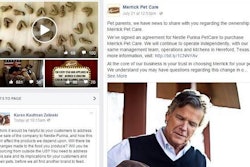Many pet food manufacturers have felt as though they’re under the microscope ever since the Food Safety Modernization Act (FSMA) was signed into law in 2011 and the US Food and Drug Administration (FDA) started writing regulations and establishing policies under the act. FDA made it clear fairly early in the process that pet food would get special treatment, and not necessarily in a good way.
The agency, specifically its Center for Veterinary Medicine (CVM), established a policy of zero tolerance for Salmonella in pet food, which is more stringent than policies for human food (before or after FSMA was passed). Considering that more than 2,200 sub-types of Salmonella exist, this bacteria is everywhere in the environment, including in pet food manufacturing facilities following the highest standards and state-of-the-art practices for sanitation, safety and quality.
Thus, over the past several years, before any formal FSMA regulations were in place—the one that will most directly affect pet food, the Preventive Controls for Animal Food rule, goes into effect on August 30—we have seen more and more pet food recalls over possible Salmonella contamination. In most cases, any Salmonella detected (often in minute amounts) was in the factory or environment, not in the pet food itself.
Yet, because FSMA gave FDA mandatory recall authority, pet food producers in this situation usually take the cautious route and issue a voluntary recall to, well, head FDA off at the pass while they re-sanitize the area in question. “The vast majority of recalls have been precautionary, resulting from routine sampling, not pets or people coming down with illnesses,” wrote Laurie Tarkan, in an article on Fortune.com about the safety, and growing popularity, of raw pet food.
To be fair, the heightened focus on pet food under FSMA has also partially arisen from the law’s intention to bring all food products consumed in the US—by humans or by animals—under the same safety and quality standards and practices. While many pet food companies already used the same or similar food safety programs and procedures common (and required) in human food, such as hazard analysis and critical control points (HACCP) for preventive action and current good manufacturing practices (cGMPs), not all did, especially cGMPS. Now they will have to.
That is probably good for the industry in the long run, particularly as pet owners have begun to pay more attention to pet food safety. Believe me, all those recalls do not go unnoticed by consumers—I even get questions from friends and family members—and because they don’t understand that most of the Salmonella-related recalls are purely precautionary, and that the number and percentage of pet food recalls is still far below that in human foods, many pet owners are under the misperception that pet food is becoming less safe.
The more that pet food companies can show they follow the same standards and practices as human food producers (especially in this time when “human grade” has become a popular marketing term and label claim, rightly or wrongly), the more they can correct this misperception and assure consumers of their products’ safety.
Yet it’s understandable that some people in the industry have felt somewhat persecuted, especially by FDA. The agency has seemingly backed off a bit on traditional pet food products, even declaring at the beginning of this year (at the American Feed Industry Association’s annual Pet Food Conference) that, because pet food manufacturers had made such “enormous strides” in reducing the prevalence of Salmonella in dry pet food—an incidence of 1.7% in samples taken during 2010-12, down from 13% in 2002-06—dry pet food will not be part of FDA’s current fiscal year Salmonella sampling plan.
Instead, FDA has now turned its attention, like a laser beam, to raw pet food. It’s not a coincidence that there have been several recalls by raw pet food companies recently; FDA essentially announced its intentions in June, when it assigned field staff to collect samples of raw pet food to be analyzed for Salmonella, Listeria monocytogenes and E. coli. I’ve even heard speculation that FDA’s intent is to “take down” this segment of the industry.
That may be getting a bit paranoid, but it’s easy to understand the concern of people and companies in the raw pet food category. And it does seem FDA is doubling down on outdated advice and policies, such as the American Veterinary Medical Association’s 2012 resolution discouraging the feeding of raw pet food. In the Fortune.com article, Tarkan quoted James Marsden, PhD, professor of food safety and security at Kansas State University, who pointed out that the technology to kill pathogens has improved dramatically since 2012. “If it’s done right, they’re very, very safe,” he says. “The industry leaders are taking measures to control contamination. If they weren’t, they would have contamination in every lot.”
Everyone in the industry may as well get used to this level of scrutiny, not to mention media interest and attention from outside the industry. The International Association for Food Protection even had a pet food safety session during its annual meeting earlier this month, with part of the session focused on jerky pet treats from China. During that segment, Lee Anne Palmer, VMD, MPH, supervisory veterinary medical officer with CVM, admitted that the agency is no closer to solving the mystery of why so many pets have become ill or died from eating such treats.
Perhaps CVM should put more resources into that investigation. But with the final FSMA preventive control rule for animal feed coming out by the end of this month, and the agency’s continuing obsession with Salmonella in pet foods, that’s not likely to happen.
















